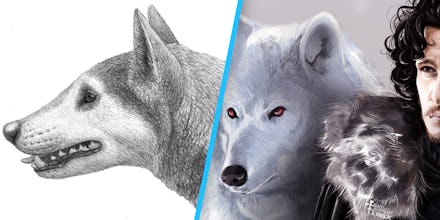The Cynarctus Wangi Made Those 'Game of Thrones' Dire Wolves Look Like Teddy Bears

Someone tell Game of Thrones' Jon Snow he picked the wrong canine companion. An animal even more badass than dire wolves existed in North America 12 million years ago, and its jaws were so strong it could crush an elephant's bones.
Meet the Cynarctus wangi.
The big discovery
Steven E. Jasinski, a paleontology doctoral student from the University of Pennsylvania, identified the new species of fossil dog from some hobbyist's beach findings in Maryland.
When the fossils were first found, Jasinski and Steven Wallace, co-authors on the paper published in the Journal of Paleontology, thought the specimens belonged to an already identified species of dog from the subfamily Borophaginae, which were characterized by the ability to eat through the bones of large animals (because they're hardcore).
But compared to the dog they thought they'd found, known as Cynarctus marylandica, something was unusual about the specimens' jaw: The teeth didn't match the presumed animal. So they named the new finding Cynarctus wangi, after Natural History Museum of Los Angeles County curator Xiaoming Wang.
Yes, dire wolves are real — but this isn't one
Dire wolves, the real ones that lived from between 300,000 and 12,000 years ago, were like the linebacker version of a modern-day gray wolf. They were heavyset, likely due to a diet of megafauna, or huge herbivores — pronghorns, mammoths and giant condors, among others.
Unfortunately (for them, definitely not for us), having their whole dinner menu revolve around mostly extinct animals meant that before long there wasn't anything to eat. And so, about 12,000 years ago, the dire wolf went extinct too.
Cynarctus wangi is a different species. Bone-crushing dogs like it have been extinct for millions of years, but they roamed North America for 15 to 20 million years before dying off, according to Jasinski. They had the ferocity of the Stark family's horde of dire wolves on Game of Thrones, but instead of killing White Walkers, they chomped through ancient elephant bones.
"The group in and of itself was variable in size, some very large — larger than wolves get today," Jasinski told Mic in a phone interview. "The size wasn't terribly far off from dire wolves. Dire wolves probably would've outcompeted these guys since they moved away from crushing bones to just eating meat."
The cool thing about Cynarctus wangi is where it was found — and what it tells us about Earth millions of years ago. Namely, which beasts were devouring one another.
"We don't have a lot of information about terrestrial animals on land on the East Coast during this time, because they aren't common," Jasinski said; most fossils from the area were from marine animals. "We knew the animals eating plants — ancient pigs, ancient elephants — but we didn't know what was eating those. This gives us an idea of what life would've been like: Bone-crushing dogs, roaming the coast in packs, hunting like the wolves or bears of today."